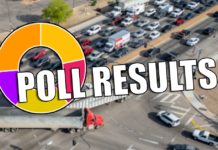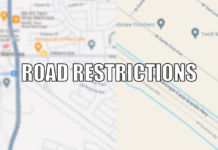Traffic on SR 347/John Wayne Parkway is heavy, as all Maricopans know. Just how much traffic is there on that stretch of highway? In March the first actual traffic count was completed, and the volume for SR 347, both northbound and southbound within the city limits, was 48,689 vehicles per day.
“Statistically, there’s more traffic on 347 than on the I-10 at Casa Grande,” explained City Transportation Director Brent Billingsley. “And,” he added, “we know that traffic on Honeycutt (both the Road and the Avenue) is increasing.”
Billingsley told the Traffic Task Force last week, “The city recognizes the problem. We’ve got a lot of challenges out there and a lot of problems.” Billingsley was at the task force meeting to answer some questions about transportation. “There’s an awful lot going on in the City of Maricopa with engineering and traffic.” Some of those endeavors include new traffic signal lights and various transportation studies relating to regional and alternative traffic flows.
The Hidden Valley regional transportation study, the largest ever to be executed in the state, will encompass western Pinal and southern Maricopa counties, including Avondale, Glendale and Buckeye. Designed to address future regional alternative routes, the study will look at north-south connections and linking Maricopa to the 303. Rights of way will be important considerations during studies like this one.
The city is also involved in the Maricopa-Casa Grande Corridor Study, the MAG Study (Maricopa Association of Governments) for input and awareness of what is happening to the north, as well as the Pinal Routes of Regional Significance Study.
A feasibility study for alternative modes of transportation, a transit study, is in the works.

City Transportation Director Brent Billingsley outlines various regional traffic routes for members of the Traffic Task Force.
Additionally, the grade separation at the Union Pacific tracks and John Wayne Parkway is the subject of a feasibility study due in Dec. It may take anywhere from six months to five years to attain funding for the project, depending on the design (whose concept could take at least a year) and the studies involved. Obtaining project funding, which can run anywhere from $30-50 million, is “the most time-consuming aspect,” according to Billingsley.
If local funds are involved, the city and ADOT (Arizona Department of Transportation) make the project decisions. If the project is federally funded, the FHWA (Federal Highway Administration) makes the decisions, potentially funding 90-92 percent of just the grade separation. Union Pacific would kick in 1-2 percent, but only for their right of way. “The good news,” Billingsley explained, “is that ADOT is in support of the project, and the FHWA is involved.
The City of Maricopa would ultimately be responsible for the funding and redesign of the intersection at the Maricopa-Casa Grande Highway as part of the grade separation project. When will that project begin? “The fastest is seven years,” said Billingsley, “and there is no guarantee.”
“Cooperation, coordination and communication are the three most vital components between city and community organizations and groups. “They are the keys to success,” Billingsley explained. One of his suggestions to the Traffic Task Force was community leadership training, a leadership academy modeled on what other communities have successfully implemented.
Such leadership training would provide an opportunity for meaningful public involvement, important to the efforts of both the city, the Public Safety Committee and the Traffic Task Force in order to make decisions as to what is best for the entire community. As Vice-Mayor Brent Murphree noted, “We all want to be on the same page, not duplicating our efforts.”









![City gave new manager big low-interest home loan City Manager Ben Bitter speaks during a Chamber of Commerce event at Global Water Resources on April 11, 2024. Bitter discussed the current state of economic development in Maricopa, as well as hinting at lowering property tax rates again. [Monica D. Spencer]](https://www.inmaricopa.com/wp-content/uploads/2024/04/spencer-041124-ben-bitter-chamber-property-taxes-web-218x150.jpg)



![Alleged car thief released without charges Phoenix police stop a stolen vehicle on April 20, 2024. [Facebook]](https://www.inmaricopa.com/wp-content/uploads/2024/04/IMG_5040-218x150.jpg)



